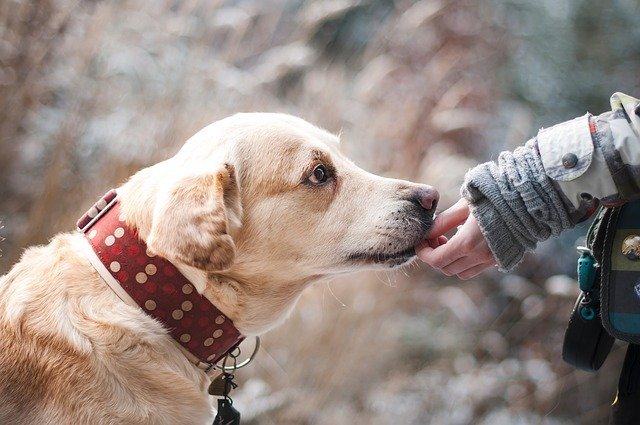
Dog pain is part of loving and caring for a dog. While of course we never wish pain or suffering on ourselves or our loved ones, it is an inevitable part of living. As a human being lucky enough to have one or more dogs in your life, you must be willing to be responsible and accountable for your dog’s health, happiness and well-being at all times.
This means that you are the steward of your animal, and must always pay close attention to your dog’s habits and behavior. Close contact and regular observation will allow you to perceive health problems which may cause your dog pain before they escalate into potentially life-threatening conditions.
In the process of paying attention, you will also learn who your dog is. This knowledge, of course, is the basis of any friendship, and no creature on earth reciprocates friendship as generously and unconditionally as your dog!
So the investment of time, attention, energy, and, yes, money, to keep your canine companion feeling great is well worth it. Effectively dealing with dog pain in an informed, mature, loving way is a significant part of your responsibility as a dog’s friend and dog-owner. Luckily, breakthrough treatments now make it possible to treat many aspects of dog pain, from the source to the symptoms, without injections, potentially toxic drugs or side effects.
COMMON CAUSES OF DOG PAIN

Dogs are mammals with highly evolved skeletal and neuro-muscular systems, much like ourselves. They are vulnerable to injury, infection and parasites. And, many breeds have inherited, genetic predispositions to severe conditions which can dramatically affect their quality of life.
SKELETAL AND MUSCULAR PAIN: HIP DYSPLASIA AND ARTHRITIS

Hip dysplasia and dog arthritis affect many dogs and are especially common in large breeds including German Shepherds, Rottweilers, Mastiffs, Spaniels and Retrievers. Purebred dogs in these groups are particularly prone, but even mixed-breeds may encounter these familiar sources of dog pain.
The condition Hip dysplasia is the ball-and-socket joint of the hip which becomes deformed, preventing full rotation of the ball in the socket. This condition is usually inherited, and become worse with age. The symptoms include chronic dog pain, cartilage-loss, loss of mobility, and atrophying of the hips and back legs.
Hip dysplasia is often accompanied by dog arthritis, which is an inflammation of the cartilage and its membranes, resulting in damage to surrounding tendons, nerves, muscle and bone. As with hip dysplasia, dog arthritis is a common cause of dog pain. While there is no cure, there are some well-known organisations offer safe, gentle effective treatment.
How to Comfort a Dog in Pain Compassionately

The experience of pain is universal. And we now know that animals experience pain in much the same way that we do, as humans. In his brilliant book, “The Exultant Ark“, author and naturalist Jonathan Peter Balcome studies and explores the capacity of animals to experience joy, as well as pain. A generation or two ago, many people believed that the “lower animals” as they were called literally did not have this ability. Science now tells us something entirely different, that even invertebrates – even shrimp! – avoid pain and seek pleasure.
So, it goes without expressing that your dog experiences the gamut of sensations from misery and agony to pure joy. The main reason why human beings love dogs is that their joy-threshold is so low. It doesn’t take much to make them ecstatically happy, and they love us so easily. They always get super excited when they see us they love to catch the ball, always excited to see the leash, always happy to run themselves silly in the dog-park….unless they are in pain.
Whenever you encounter your dog, another animal, another person, or any other living being, consider these words:
- Compassion
- Sympathy
- Empathy
- Pathology
- Pathetic
These words arise from the same source. “Passion” is a word which comes from the Latin language word which comes from the Greek word, “pathos”. The original root-words refer to the experience of suffering. When we realize that all beings may experience pain, our view of the world changes
HOW TO TELL WHEN YOUR DOG IS IN PAIN:

Because you are in tune with your dog, the first signal that something may be wrong may simply be a change in how your canine friend looks, moves, and relates to you and the rest of your family.
WARNING: Even a subtle change in behaviour, appearance, or both may be your first clue that your dog’s health needs to be checked out by a veterinarian.
As the dog’s best friend, dog pain will be more immediately apparent to you than it will be in many cases. Of course, a visible injury (broken bone, bleeding cut or laceration) is unmistakable, but often dog pain comes from a source which cannot be seen by the naked eye, such as dog arthritis and hip dysplasia. It’s estimated that 1 in 4 dogs will experience dog arthritis, and this condition often is accompanied by hip dysplasia. Early, accurate diagnosis and treatment with these natural formulas, which were developed by a naturopathic doctor for his dog, are vital steps to effectively intercepting and managing dog pain so that your pet’s suffering is kept to a minimum.
Some breeds are genetically engineered not to show pain. For instance, Pit Bulls are more likely to suppress their feelings of discomfort. It is part of their inherited makeup as a breed! Other large breeds also often display this Stoic tendency. This can make the identification and diagnosis process more difficult.
HINT: LOOK FOR SIGNS OF SUBMISSION.

Many large, aggressive breeds will not easily show pain because they have been bred to assume a dominant pack-attitude. If your dog, regardless of the breed, shows signs of submission-passive behaviour– at inappropriate times, these may be signals of dog pain:
- Lowered head – this is where we get our expression, “Hang-dog.”
- Slumped posture
- Flattened ears
- Lying down instead of standing or sitting in the alert position
- Avoids interaction with you, other humans, other dogs
- Soft whining
- Refusal to compete, even in a “safe”, play environment
- Avoids eye-contact
- Allowing other dogs to consume their food
- Allowing other dogs to “move to the front of the line” at meal-times
And don’t be fooled by tail-wagging. We want to believe that only happy dogs wag their tails. Tail-wagging may be a sign of submission. The dog may be trying to comfort YOU and assure you that everything is fine, and does so by generously wagging its tail.
If your dog just seems different – “off”-keep checking. Loss of appetite and loss of energy are obvious first clues.
A dog whose suffering may be sluggish and lethargic, with no interest in the everyday joys of dog-dom like daily walks, rides in the car, trips to the dog park, catching the Frisbee and fetching the ball.
And, a dog in pain may also turn aggressive. Undiagnosed problem is often the underlying cause of a sudden “snap” in dog personality, including biting.
DO A NOSE-TO-TAIL QUICK-CHECK FOR DOG PAIN

If you sense that your dog is experiencing pain, give your pet a nose-to-tail check yourself. Doing this daily, even when your dog seems to be a perfect shape, keeps you and your dog closely connected. Daily analysis of the “whole” dog may help you keep your dog’s quality of life at its peak.
Begin by bathing your dog if this is part of your usual routine. Or, start with a gentle brushing, or even just a light fur-ruffling and head-to-tail stroking with your hands. If the dog jumps, snaps winces or flinches when you touch it, take note of where your hands are when this happens. Arthritis and hip dysplasia, widespread sources of dog pain, may make your dog hypersensitive to even the gentlest touch on its joints, legs and hips.
- COAT AND FUR – Pay attention to the dog’s skin. If the hair seems unusually dull, clumped, or matted, this may indicate that your dog is not a grooming-a common sign of dog pain and possible illness.
TIP: Also, look for areas around the joints where the fur seems to have changed colour. Dog pain in a leg or hip often causes the dog to lick that area obsessively, and the constant saturation with the enzymes in the dog’s saliva bleaches the hair to a lighter tone.
- START AT THE NOSE – The nose-” leather” should be clean, shiny, cold and moist. A dry, cracked, or swollen nose may indicate inflammation, dehydration or even fever and infection in your dog’s system. Be aware of unusual discharge (dark, green, yellow, and traces of blood).
- EYES – Should be bright. Lightly move the lower lids with your fingertip to get a look at the mucus membrane. All mammalian eyes and noses produce some discharge. Normal discharge is thin and transparent and will wipe off easily with a warm washcloth. Look for signs of inflammation or infection. Dilated pupils may indicate fever.
- MOUTH – Dogs are infamous for their “doggy-breath”, so don’t expect a bouquet of roses. But do make your dog’s dental health concern. Canine toothpastes are available for home use, and every veterinarian offers professional teeth cleaning for pets. This helps prevent painful abscesses which can make your dog ill and lead to tooth loss. Dogs also drool-many breeds in particular. However, if your dog is drooling or panting unusually, you may be facing dog pain.
- HEAD AND THROAT – Press through the fur gently to feel for any lesions, such as a wound from a fight, lumps, bumps, or any cysts or other thickening under the hair and skin. A bite-wound from another dog, or any kind of wound, may go undetected in long-haired dogs especially. Untreated injuries may lead to infection.
- CHEST AND SHOULDERS – When you feel your dog’s chest, shoulders, feel for its heartbeat. A rapid pulse often indicates that the animal is suffering and trying to cope with pain. Overdeveloped chest and shoulders may show weakness in the rear legs, often accompanied by dog pain.

TIP: Pay careful attention to how your dog stands and walks. Dogs who are experiencing hip dysplasia or arthritis in their hips and back legs will often slump or lower their hindquarters. This is done to weight from the painful areas, and tend to place more weight on their front legs. This will often result in the dog standing with its rear legs unusually close together, and its front legs wide apart.
Also watch for changes in your dog’s walk-pattern or run-pattern. When a dog has pain in its back legs, it often will “bunny hop”, using both of its rear legs like a pogo-stick since normal weight-distribution may be painful. If your dog limps or displays a gait-pattern like a bunny-hop, it is a clear sign of dog pain, so seek medical attention immediately.
- BELLY– Your dog’s mid-section is where many significant organs are located. A bloated or tender tummy indicates an internal issue and requires immediate attention. Constipation is a common cause, so monitor your dog’s bowel and bladder elimination patterns closely. Pay attention to weight loss and gain. A dog experiencing pain often will stop eating.
- JOINTS AND LIMBS– In healthy mammals, light, evenly applied tactile pressure feels good. This is the appeal of a massage. If your dog reacts-pulls its paw away, snaps, whines-when you touch one of its joints, it is likely that dog arthritis, hip dysplasia or both are present.
TAIL-Your dog will probably wag its tail just to make you feel better, even if it is in pain. Do take note of changes in mood and personality. Look under the seat for unusual discharge from the anus or female urogenital structure. These tissues should be smooth, clean and moist, like healthy gum-tissue. Seek immediate veterinary assistance at any sign of swelling, bleeding or inflammation in these areas, since these are indicators of health issues and accompanying dog pain.

